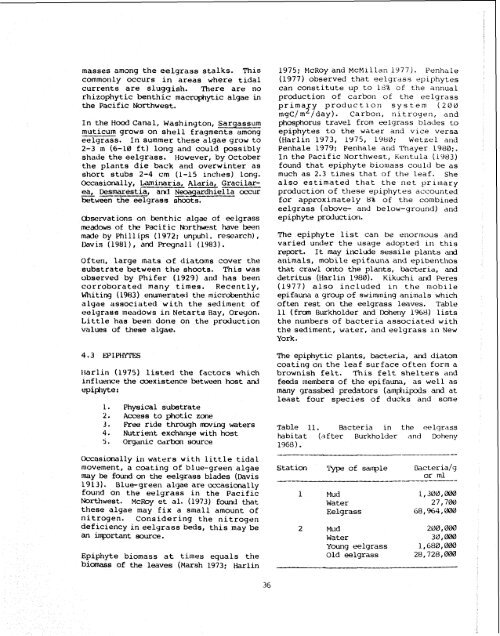The ecology of eelgrass meadows in the Pacific Northwest: A ...
The ecology of eelgrass meadows in the Pacific Northwest: A ...
The ecology of eelgrass meadows in the Pacific Northwest: A ...
- No tags were found...
You also want an ePaper? Increase the reach of your titles
YUMPU automatically turns print PDFs into web optimized ePapers that Google loves.
masses among <strong>the</strong> <strong>eelgrass</strong> stalks. This<br />
commonly occurs <strong>in</strong> areas where tidal<br />
currents are aluggieh. <strong>The</strong>re are no<br />
rhizophytic benthic macrophytic algae <strong>in</strong><br />
<strong>the</strong> <strong>Pacific</strong> <strong>Northwest</strong>.<br />
In <strong>the</strong> Hood Canal, Wash<strong>in</strong>gton, Sargassum<br />
muticum grows on shell fragments among<br />
eelyrass, In summer <strong>the</strong>se algae grow to<br />
2-3 m (6-L0 ftf long and could possibly<br />
shade <strong>the</strong> <strong>eelgrass</strong>. However, by October<br />
<strong>the</strong> planta die back and overw<strong>in</strong>ter as<br />
short stubs 2-4 cm (1-15 rnct~es) long.<br />
Qccas~~.rally, Lam<strong>in</strong>aria, Alaria, Gracilar-<br />
-- ea, ~smarestia, atxi Necxg2irdhiella occur<br />
&tween <strong>the</strong> eelgrasa shoots.<br />
Cbscnrations on benthic algae <strong>of</strong> elgrass<br />
wadows <strong>of</strong> tk Pacitic Nortkst have been<br />
made by Phill ips (1972; unpubl. research),<br />
Davis (1981), and Procjnall (1983).<br />
Often, Large mats <strong>of</strong> diatotns cover <strong>the</strong><br />
substrata between <strong>the</strong> shoots. This was<br />
observed by Phifer (1929) and has been<br />
corroborated many times. Recently,<br />
W~it<strong>in</strong>g (1983) anumeratal <strong>the</strong> micr-nthic<br />
alq&o E L S L ~ ~ C L with ~ ~ U <strong>the</strong> ~ setlimeut <strong>of</strong><br />
euLqraea tneadows <strong>in</strong> Netarts Hay, Oregon.<br />
Little has been done an <strong>the</strong> procluct~on<br />
values <strong>of</strong> Ulese algae.<br />
1975; McRoy and McMlllan 1977). Penhale<br />
(1977) observed that eelgrdss epiphytes<br />
can constitute up to 1~3% oE <strong>the</strong> annual<br />
production <strong>of</strong> carbon <strong>of</strong> <strong>the</strong> <strong>eelgrass</strong><br />
primary production system (20Gt<br />
mgc/m2/day). Carbon, nltroyen, and<br />
phosphorus travel from t-lgrass blades to<br />
epiphytes to <strong>the</strong> water and vice versa<br />
(Harl<strong>in</strong> 1973, 1975, 19W; Wetzel ailti<br />
Penhale 1979; Penhale atd Thayer 1980:.<br />
In <strong>the</strong> <strong>Pacific</strong> <strong>Northwest</strong>, Keiltula (i983)<br />
found that epiphyte biomass coultf be as<br />
much as 2.3 tlmes that <strong>of</strong> <strong>the</strong> Leaf. she<br />
also estimated that <strong>the</strong> net prrrnary<br />
productlon <strong>of</strong> <strong>the</strong>se epiphytes accounted<br />
for approximately 85 <strong>of</strong> <strong>the</strong> cornbilled<br />
<strong>eelgrass</strong> (above- and below-ground) and<br />
epiphyte prorluction.<br />
<strong>The</strong> epiphyte list can be enornlous and<br />
varied urider <strong>the</strong> usage ddopted r11 th~s<br />
report. It may <strong>in</strong>clude sessrle plants axl<br />
animals, mobile epifauna and epibenthos<br />
+A&t crawl onto <strong>the</strong> plants, bacterld, and<br />
detritus (tlarlm 190B). Kikuchl ad Peres<br />
(1977) also <strong>in</strong>cluded In <strong>the</strong> rnobile<br />
epifauna a group <strong>of</strong> swir~n<strong>in</strong>g anrmals which<br />
<strong>of</strong>ten rest on <strong>the</strong> <strong>eelgrass</strong> leaves. Table<br />
11 I from Burkholder and 1)rjheriy l96U) lists<br />
<strong>the</strong> numbers <strong>of</strong> bacterla associated with<br />
<strong>the</strong> sediment, water, and <strong>eelgrass</strong> Ln New<br />
York .<br />
tlarl<strong>in</strong> I19751 listed <strong>the</strong> factors which<br />
~nf luetlce <strong>the</strong> coexistence between host an3<br />
c"pi#lyte r<br />
1. Physical substrate<br />
2. Rccwas to photic zone<br />
3. F'tw rrlde through w<strong>in</strong>g waters<br />
4. Nutrient excharge with host<br />
5. Oqctnic cdrborl wwcw<br />
<strong>The</strong> epiphytic plants, bacteria, and diatom<br />
coat<strong>in</strong>g on <strong>the</strong> leaf surface <strong>of</strong>ten form a<br />
brownish felt. This felt shelters and<br />
feeds members <strong>of</strong> <strong>the</strong> epifauna, as well as<br />
<strong>in</strong>at~y grassbed predators (amphipods and at<br />
least four species <strong>of</strong> ducks and some<br />
Table 11. Bacteria <strong>in</strong> <strong>the</strong> <strong>eelgrass</strong><br />
hbitat ( ~ ter f Burkholder and IBheny<br />
1968) .<br />
---- ----<br />
Ol.casion*Lly it; waters with little tidal<br />
movument, coat<strong>in</strong>g <strong>of</strong> blue-green algae Station '1- <strong>of</strong> sample bcteria/g<br />
my ba found otl <strong>the</strong> <strong>eelgrass</strong> blades (Davis<br />
--------<br />
or ml<br />
1913). Blue-green algae are occasionally<br />
found on <strong>the</strong> eelyrass <strong>in</strong> <strong>the</strong> <strong>Pacific</strong> 1 Mud 1,388,0@0<br />
<strong>Northwest</strong>. McRy et al. (1973) found that Water 27,7W<br />
<strong>the</strong>se algae may fix a small amount oE Eelgrass 68,964,W<br />
nitrogen. Consider<strong>in</strong>g <strong>the</strong> nitrogen<br />
dsf iciency <strong>in</strong> <strong>eelgrass</strong> beds, this may be 2 Mud 2@0,L%M<br />
an hnprtant source. Water 30,000<br />
Young elgrass 1,600,000<br />
Epiphyt@ biomass at times equals <strong>the</strong> Old <strong>eelgrass</strong> 28,72c3,000<br />
biomass <strong>of</strong> <strong>the</strong> leaves (Marsh 1973; Harl<strong>in</strong><br />
36

















